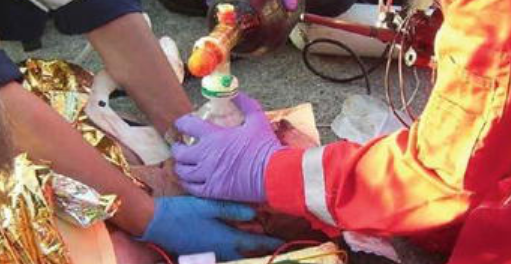Emergency intubation is a critical procedure that often presents a multitude of challenges, especially in high-pressure situations. The ability to secure an airway swiftly and efficiently can be the difference between life and death. However, several factors can complicate this already complex task, making it crucial for medical professionals to be well-prepared and adaptable. Below, we delve into some of the primary factors that contribute to the difficulty of emergency intubation, drawing on insights from Richard Levitan’s Airwaycam.com. Additionally, we outline the Rapid Sequence Induction (RSI) process, which is a systematic approach designed to mitigate these challenges and ensure successful intubation.
Factors Contributing to Difficult Emergency Intubation
1. Provider Experience and Proficiency
The experience and proficiency of the provider, along with their mental ability to make clear, concise, evidence-based decisions, can be the difference in first-pass success. The dynamics of making decisions about whether to take away the patient’s ability to breathe should be discussed long before patient encounters. Preparing providers with physical skills is only a small portion of the job; giving them a strong foundation regarding the mental approach to RSI is key.
2. Dynamically Deteriorating Clinical Situation
One of the foremost challenges in emergency intubation is the rapidly evolving nature of a patient’s clinical condition. When a patient’s health is deteriorating dynamically, there is an urgent “need for speed.” This urgency can lead to increased stress and pressure on the medical team, potentially affecting their performance and decision-making capabilities.
3. Non-Cooperative Patient
In many emergency situations, patients may be non-cooperative due to altered mental status, panic, or severe pain. This lack of cooperation can make it exceedingly difficult to position the patient properly, visualize the airway, and perform the intubation smoothly. Effective communication and pharmacological intervention are necessary to manage such patients.
4. Respiratory and Ventilatory Compromise
Patients requiring emergency intubation often have compromised respiratory and ventilatory functions. Conditions such as severe asthma, chronic obstructive pulmonary disease (COPD), or acute respiratory distress syndrome (ARDS) can make it difficult to ventilate the patient adequately during the procedure. These conditions necessitate a higher level of skill and precision from the intubating clinician.
5. Impaired Oxygenation
Impaired oxygenation is a significant concern during emergency intubation. Hypoxia can occur rapidly, particularly in patients with preexisting respiratory conditions or severe illness. Maintaining adequate oxygenation throughout the intubation process is critical, yet challenging, and requires careful pre-oxygenation and monitoring.
6. Full Stomach
The presence of a full stomach increases the risk of regurgitation, vomiting, and aspiration during intubation. This risk is particularly high in emergency situations where patients have not been fasting. The need to protect the airway from aspiration adds an additional layer of complexity to the procedure.
7. Extremely Short Safe Apnea Times
Patients in critical condition often have extremely short safe apnea times, meaning they cannot tolerate even brief periods without ventilation. This necessitates a rapid and efficient intubation process to minimize the time the patient is without adequate oxygenation.
8. Secretions, Blood, Vomitus, and Distorted Anatomy
Lastly, the presence of secretions, blood, vomitus, and distorted anatomy can significantly hinder the visualization of the airway and the intubation process. These factors can obscure landmarks and make it difficult to pass the endotracheal tube. Suction devices and advanced airway management tools are essential to manage these challenges effectively.
Rapid Sequence Induction (RSI) Sequence
Rapid Sequence Induction (RSI) sometimes known as Rapid Sequence Intubation, is a technique used to facilitate quick and safe intubation, particularly in emergency situations. The RSI process is designed to address and mitigate the challenges outlined above through a structured sequence of steps:
1. Plan
Proper planning involves preparing the necessary drugs, equipment, personnel, and the environment. Having a procedure checklist can ensure that no steps are missed. By following this checklist, RSI can be performed in the exact same sequence every time, thus reducing the risk to the patient and ensuring the provider that all steps are followed. This can increase first-pass success.
2. Preparation
This step includes assembling all required drugs, checking equipment functionality, organizing the team, and ensuring the environment is conducive to a successful intubation.
3. Protect the Cervical Spine
Especially important in trauma patients, protecting the cervical spine prevents further injury during the intubation process. Manual in-line stabilization or a cervical collar can be used.
4. Positioning
Optimal patient positioning is crucial for successful intubation. While some clinicians prefer to position the patient after administering paralytic agents, initial positioning can enhance visualization of the airway. The sniffing position and a 30 degree inclination improves visualization. However this may not be possible in a suspected cervical neck injury.
5. Pre-oxygenation
Providing 100% oxygen to the patient before intubation can increase the time available for the procedure by delaying the onset of hypoxia. This step is vital for patients with compromised oxygenation. Remember hypoxaemia is a common presentation in critically ill patients, with the potential for severe harm if not addressed early.
6. Pretreatment (Optional)
In certain cases, pre-treatment with medications such as atropine, fentanyl, and lignocaine can help mitigate the physiological responses to intubation. This step is patient-specific and may not always be necessary.
7. Paralysis and Induction
Administering induction agents followed by paralytic agents ensures rapid and effective paralysis, facilitating easier intubation. Here are the commonly used agents:
Induction Agents:
- Ketamine: 1.5-2 mg/kg IBW. Onset: 60-90 sec. Duration: 10-20 min.
- Use: Suitable for any RSI, especially if hemodynamically unstable.
- Drawbacks: Increased secretions, caution in cardiovascular disease, laryngospasm (rare).
- Etomidate: 0.3-0.4 mg/kg TBW. Onset: 10-15 sec. Duration: 5-10 min.
- Use: Suitable for most situations including hemodynamically unstable.
- Drawbacks: Adrenal suppression, myoclonus, pain on injection.
- Fentanyl: 2-10 mcg/kg TBW. Onset: <60 sec. Duration: 30 min – 6h.
- Use: Low doses as a sympatholytic premedication; in hemodynamically unstable conditions.
- Drawbacks: Respiratory depression, apnea, hypotension, slow onset.
- Midazolam: 0.1-0.3 mg/kg TBW. Onset: 60-90 sec. Duration: 15-30 min.
- Use: Not usually recommended for RSI, some use in shocked patients.
- Drawbacks: Respiratory depression, hypotension, paradoxical agitation.
- Propofol: 1-2.5 mg/kg IBW + (0.4 x TBW). Onset: 15-45 sec. Duration: 5-10 min.
- Use: Haemodynamically stable patients, reactive airways disease.
- Drawbacks: Hypotension, myocardial depression, pain on injection.
- Thiopental: 3-5 mg/kg TBW. Onset: 30-45 sec. Duration: 5-10 min.
- Use: Haemodynamically stable patients, status epilepticus.
- Drawbacks: Histamine release, myocardial depression, hypotension.
Paralytic Agents:
- Suxamethonium (Succinylcholine): 1-2 mg/kg TBW. Onset: 45-60 sec. Duration: 6-10 min.
- Use: Widely used unless contraindicated.
- Drawbacks: Hyperkalemia, malignant hyperthermia, bradycardia.
- Rocuronium: 0.6-1.2 mg/kg IBW. Onset: 60 sec. Duration: 45-60 min.
- Use: Can be used for any RSI.
- Drawbacks: Rare allergy.
- Vecuronium: 0.15-0.25 mg/kg IBW. Onset: 120-180 sec. Duration: 45-60 min.
- Use: Not recommended for RSI unless no other options available.
- Drawbacks: Slow onset, long duration.
8. Placement with Proof
The provider’s ability to recognize the anatomy of the airway is crucial, as many patients requiring emergency airways may have deformities, edema, or foreign bodies that impede the ability to recognize the structures of the airway or visualize the airway itself. The use of a bougie can improve the outcome of first-pass success. The confirmation of correct placement is best achieved with waveform capnography, which provides continuous monitoring of exhaled carbon dioxide levels, ensuring the tube is in the trachea and not the esophagus.
9. Postintubation Management
After securing the airway, ongoing management is necessary to ensure continued ventilation, oxygenation, and stability of the patient. Continuous capnography is paramount, along with monitoring the patient for other potential complications. Remember effective management not only involves delivery of adequate analgesia and sedation, but also efficient titration of the ventilator
Successful RSI: Team Communication and Preparation
RSI is only successful when there is clear and concise communication within the team and everyone knows their roles. Mental preparation is done well before encountering a patient, ensuring that decision-making is swift and precise. The decision to perform or not perform RSI and/or proceed to a surgical cricothyroidotomy is crucial and should be based on thorough knowledge, training, and situational awareness.
Conclusion
Emergency intubation is a high-stakes procedure fraught with numerous challenges. Understanding and anticipating the factors that can complicate this process, alongside following a structured RSI sequence, are vital for improving patient outcomes. Training, experience, and the ability to stay calm under pressure are essential traits for medical professionals performing emergency intubations. By acknowledging and preparing for these challenges, healthcare providers can enhance their readiness and effectiveness in performing emergency intubations, ultimately saving more lives in critical situations.
Feel free to connect and share your thoughts or experiences related to emergency intubation. Let’s continue to learn and improve together in our mission to provide the best possible care for our patients.




